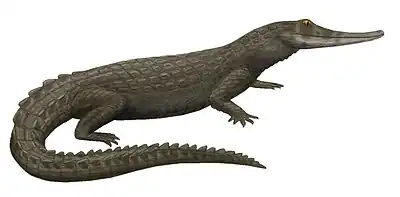| Aprosuchus Temporal range: Maastrichtian | |
|---|---|
| Scientific classification | |
| Domain: | Eukaryota |
| Kingdom: | Animalia |
| Phylum: | Chordata |
| Class: | Reptilia |
| Clade: | Archosauria |
| Clade: | Pseudosuchia |
| Clade: | Crocodylomorpha |
| Family: | †Atoposauridae |
| Genus: | †Aprosuchus Venczel and Codrea, 2019 |
| Type species | |
| †Aprosuchus ghirai Venczel and Codrea, 2019 | |
Aprosuchus is a genus of small-bodied Maastrichtian atoposaurid Eusuchian from the Hateg Basin, Romania.[1]
Discovery and naming
Aprosuchus is known from an incomplete three-dimensional skull and closely associated mandibles (Holotype UBB V.562/1) as well as a cervical vertebrae found in association with the cranial remains (referred specimen UBB V.562/2). The fossils were found in Maastrichtian sediments of the Pui Gater locality in the Hateg Basin in modern day Transylvania, Romania.[1]
The name derives from the Hungarian "apró" meaning small and the Ancient Greek σοῦχος, soukhos ("crocodile"). The species name ghirai honors Ioan Ghira from the Babeș-Bolyai University, Cluj-Napoca, for his contributions to Herpetology.[1]
Description
Aprosuchus was a small sized brevirostrine Eusuchian with an estimated body length of 600 mm. It differs from other crocodylomorphs through large palpebral strongly fused to the orbital margin of the prefrontals and frontals and partly overlapping the prefrontal and lacrimal and heterodont dentition. Aprosuchus dentition preserves at least four different morphotypes, pseudocaniniforms, pseudoziphodont lanceolate, ziphodont lanceolate and ‘low-crowned’ teeth. A further autapomorphy is the w-shaped overlap between the nasals and prefrontals which differentiates Aprosuchus from Sabresuchus symplesiodon.[1] The presence of four different tooth morphotypes casts doubt over the identification of atoposaurids based on teeth beyond a family level.[1]
Phylogeny
The following phylogenetic tree is based on the results of Venczel and Codrea 2019 using their strict consensus tree resulted from the four most parsimonious trees (Alligatorium excluded). They recovered that Aprosuchus ghirai appeared to be closely allied to other atoposaurids while Wannchampsus and the Glen Rose Form stood outside of the clade, but still closer to atoposaurids than to paralligatorids.[1]
| |||||||||||||||||||||||||||||||||||||
The paper's strict consensus tree resulted from the two most parsimonious trees (Alligatorium included) recovered similar results, retaining the sister group relationship between the Wannchampsus + Glen Rose Form clade as well as the sister group relationship between atoposaurids and paralligatorids.[1]
| |||||||||||||||||||||||||||||||||||||||||||
Paleobiology
The presence of the fossil remains of two distinct genera of atoposaurids, alongside tentatively referred isolated teeth of the possibly durophagous Eusuchian Acynodon (cf. Acynodon sp.)[2][3] and the larger Allodaposuchus[4] implies the existence of a diverse and complex ecosystem present on the Transylvanian landmass during the Maastrichtian. In this ecosystem the small bodied Aprosuchus would have most likely preyed on invertebrates and small vertebrates.[1]
The presence of Aprosuchus suggests that survivors of the Late Jurassic/Early Cretaceous atoposaurid lineage managed to survive up to the Late Cretaceous by colonising complex island ecosystems in the archipelagos of the Eastern Tethys.[1]
References
- 1 2 3 4 5 6 7 8 9 Venczel, Márton; Codrea, Vlad A. (2019-03-19). "A new Theriosuchus-like crocodyliform from the Maastrichtian of Romania". Cretaceous Research. 100 (100): 24–38. doi:10.1016/j.cretres.2019.03.018. S2CID 133729562.
- ↑ Delfino, Massimo; Martin, Jeremy E.; Buffetaut, Eric (2008-09-26). "A new species of Acynodon (Crocodylia) from the upper cretaceous (Santonian–Campanian) of Villaggio del Pescatore, Italy". Palaeontology. 51 (5): 1091–1106. doi:10.1111/j.1475-4983.2008.00800.x.
- ↑ Martin, Jeremy E.; Csiki, Zoltan; Grigorescu, Dan; Buffetaut, Eric (2008-09-26). "Late Cretaceous crocodilian diversity in Haţeg Basin, Romania". Hantkeniana (5): 31–37.
- ↑ Delfino, Massimo; Codrea, Vlad; Folie, Annelise; Dica, Paul; Godefroit, Pascal; Smith, Thierry (2010-08-02). "A complete skull of Allodaposuchus precedens Nopcsa, 1928 (Eusuchia) and a reassessment of the morphology of the taxon based on the Romanian remains". Journal of Vertebrate Paleontology. 28 (1): 111–122. doi:10.1671/0272-4634(2008)28[111:ACSOAP]2.0.CO;2.


